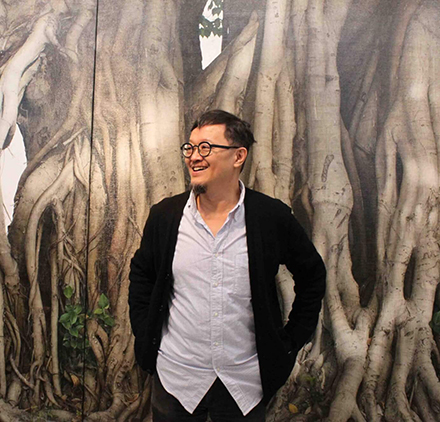
 Born in Taipei, Taiwan in 1959, Lu Hsien-Ming graduated from the Department of Fine Arts at the Chinese Culture University in 1982. At the age of 23, he received the First Prize of the New Talent Award of Hsiung-Shih Fine Arts. Since the late 1980s, Lu has been an active figure in Taiwan's contemporary art scene, notably within the "Taipei Art Group" and "Hantoo Art Group," both centered around the Chinese Culture University. He has served as President of the Huagang Chinese Modern Arts Society and Chief Editor of Mountain Wind Art News (1984), President of the Taipei Art Group (1992), and held various key roles—including Secretary-General and Board Member—within the Association of the Visual Arts in Taiwan (AVAT) from 1995 to 2018. Between 2003 and 2007, he was also President of the "Hantoo Art Group".
Born in Taipei, Taiwan in 1959, Lu Hsien-Ming graduated from the Department of Fine Arts at the Chinese Culture University in 1982. At the age of 23, he received the First Prize of the New Talent Award of Hsiung-Shih Fine Arts. Since the late 1980s, Lu has been an active figure in Taiwan's contemporary art scene, notably within the "Taipei Art Group" and "Hantoo Art Group," both centered around the Chinese Culture University. He has served as President of the Huagang Chinese Modern Arts Society and Chief Editor of Mountain Wind Art News (1984), President of the Taipei Art Group (1992), and held various key roles—including Secretary-General and Board Member—within the Association of the Visual Arts in Taiwan (AVAT) from 1995 to 2018. Between 2003 and 2007, he was also President of the "Hantoo Art Group".
Lu's artistic practice has been profoundly shaped by the socio-political transformations of Taiwan. Between 1979 and 1987, during his formative years of study, military service, and early career, as well as through the sweeping changes following Taiwan's lifting of martial law, his work evolved from an austere and restrained style to one marked by critical engagement and emotional intensity.
In the early 1990s, his Bridge Period (1991-1996) responded to Taiwan's rapid socio-political shifts, depicting overpasses, construction vehicles, scaffolding, and high-rises through thick impasto and upward perspectives. These monumental, uninhabited urban landscapes underscored the alienation of individuals in the tide of modernization. In the Figures Period (1996-2007), Lu turned his gaze to society's marginalized—elderly, vendors, and laborers—rendered with refined realism and a palpable human warmth. He incorporated LED ticker-like texts into his compositions, juxtaposing human vulnerability against cold, monotonous backdrops to critique the isolation brought by accelerated urban development.
Entering the 21st century, Lu embarked on his Urban Theater Series (2007-2016), integrating stainless steel and other industrial materials into his paintings. The interplay of polished metal and dense oil pigment generated heterogeneous urban spaces, expanding painting into semi-installational forms and probing human existence within industrialized cities.
Since 2017, Lu has transitioned into the Old Trees Period, shifting focus from urban structures to nature, time, and life itself. His works oscillate between dense, vigorous brushwork and refined, lyrical tones, moving fluidly between realism and abstraction. These landscapes become spiritual cartographies—at once introspective and universal—reflecting a deepened humanistic concern and evoking profound resonance in viewers.
Across decades, Lu's art has consistently centered on the human condition, whether through urban structures, symbolic objects, or natural imagery. His stylistic trajectory has progressed from fierce critique to a balance of reason and emotion, incorporating diverse techniques and cross-media experiments. Through his practice, Lu engages with the pulse of society, portraying the evolving cultural identity of Taiwan.
His works have received numerous accolades, including Honorable Mention at the Contemporary Art Trends in the Republic of China exhibition at the Taipei Fine Arts Museum (1988), First Prize at the 1992 Taipei Biennial of Contemporary Art, and the 2nd Liao Chi-Chun Oil Painting Award (2002). His four-part oil painting series New Era (1995) was included in Art in America's 1995 Slides Survey of Contemporary Art.
Lu's works have been exhibited internationally across Japan, Korea, China, Singapore, and Mongolia, and are held in major collections such as the Ludwig Forum for International Art (Germany), Long Museum (Shanghai), White Rabbit Gallery (Sydney), National Taiwan Museum of Fine Arts, Taipei Fine Arts Museum, Kaohsiung Museum of Fine Arts, National Museum of History, and Taitung Art Museum.